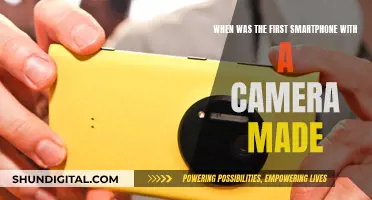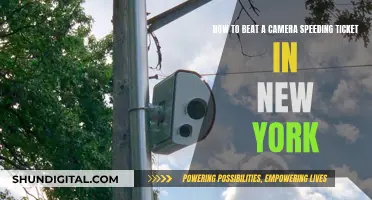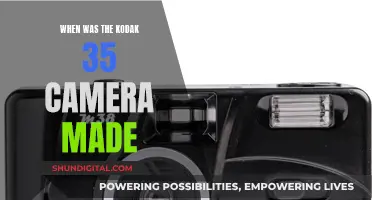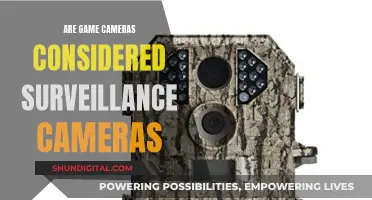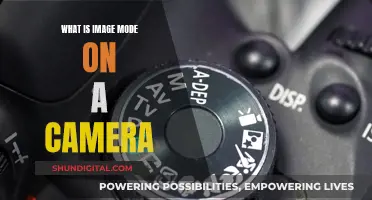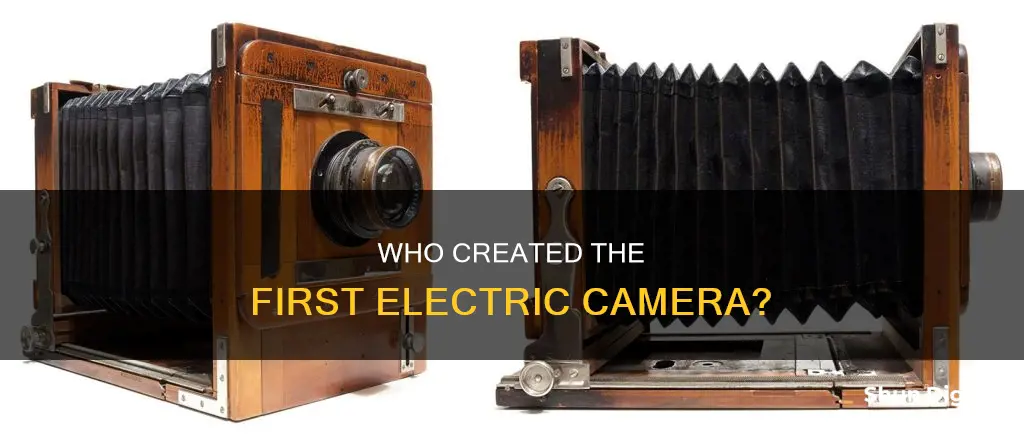
The history of the camera is a long and fascinating one, stretching back centuries before the first electric camera was even conceived of. The earliest known device resembling a camera was the camera obscura, first described by Han Chinese philosopher Mozi in the 5th century BCE. This device used a small aperture to project an inverted image onto a surface, and was used as a drawing aid for centuries.
The first true camera was invented in the early 19th century by Joseph Nicephore, who discovered that light from a pinhole camera could create a light-and-dark pattern on a metal plate coated in bitumen. This image would persist for a few hours. Nicephore worked with Louis Daguerre to perfect this process, and in 1839 they licensed the daguerreotype invention to the French government. This is often considered the birth of modern photography.
The first electric camera was patented in 1972 by Texas Instruments Incorporated. However, it was not until 1981 that Sony Corporation brought the first commercial electronic model to market. This camera used a video camera to capture images, which were then stored on a mini computer disk drive. As electronic components became cheaper and more advanced, digital cameras began to gain market share, and in the 1990s they became widely available to consumers.
| Characteristics | Values |
|---|---|
| Inventor | Steven Sasson |
| Year of Invention | 1975 |
| Company | Kodak |
| Prototype Name | N/A |
| Camera Weight | 8 pounds (3.6 kg) |
| Camera Resolution | 0.01 megapixels (10,000 pixels) |
| Camera Image Output | Black and White |
| Image Recording Time | 23 seconds |
What You'll Learn
- The first digital camera was created by Steven Sasson at Kodak in 1975
- The first digital camera was a black-and-white, battery-operated, self-contained camera
- The first digital camera weighed 8 pounds (3.6 kg) and used a Fairchild CCD image sensor
- The first digital camera had a resolution of 0.01 megapixels (10,000 pixels)
- The first digital camera took 23 seconds to record an image

The first digital camera was created by Steven Sasson at Kodak in 1975
Sasson's invention was a result of his passion for electronics and exploring new technologies. As a child, he built an amateur radio and later pursued a degree in electrical engineering. He joined Kodak shortly after graduating and was tasked with finding a practical use for the recently created charged coupled device (CCD).
While Sasson's prototype was not the first camera to produce digital images, it was the first handheld digital camera. Prior examples of digital cameras included the Multi Spectral Scanner on Landsat 1, which captured digital photographs of Yosemite, and the Cromemco Cyclops, a hobbyist camera introduced in 1975.
Sasson's work on the digital camera at Kodak faced initial skepticism and resistance. The company, which had a lucrative monopoly on film photography, was reluctant to embrace the new technology. Despite this, Sasson persevered, and his invention revolutionized the world of photography. In recognition of his achievement, Sasson received the National Medal of Technology and Innovation from President Barack Obama in 2009.
Charging Your Fujifilm Camera: A Step-by-Step Guide
You may want to see also

The first digital camera was a black-and-white, battery-operated, self-contained camera
The first digital camera was invented by Steven Sasson, an American electrical engineer who joined Kodak shortly after graduating from Rensselaer Polytechnic Institute in 1972 with a Bachelor of Science degree in electrical engineering. Sasson is recognised as the inventor of the self-contained (portable) digital camera.
In 1975, Sasson developed a portable, battery-operated, self-contained digital camera at Kodak. Weighing 3.6 kg, the camera used a Fairchild CCD image sensor with a resolution of 0.01 megapixels. The images were recorded onto a cassette tape, a process that took 23 seconds per image. The camera took images in black and white.
Sasson's prototype was not the first camera to produce digital images, but it was the first handheld digital camera. Prior examples of digital cameras include the Multi Spectral Scanner on Landsat 1, which took digital photographs of Yosemite in 1972, as well as cameras used for astronomical photography and the Cromemco Cyclops, a commercial product and hobbyist camera.
Olympus Camera Battery: How Long Does It Last?
You may want to see also

The first digital camera weighed 8 pounds (3.6 kg) and used a Fairchild CCD image sensor
The first digital camera was created in 1975 by Steven Sasson, an engineer at Eastman Kodak. Weighing 8 pounds (3.6 kg), Sasson's camera was a technical exercise and not intended for production. It used Fairchild Semiconductor's CCD image sensor chips, which were developed in 1973, and recorded black-and-white images onto a cassette tape. The camera had a resolution of 0.01 megapixels (10,000 pixels) and took 23 seconds to capture its first image.
The CCD image sensor, or charge-coupled device, was invented in 1969 by Willard S. Boyle and George E. Smith at Bell Labs. The CCD is a semiconductor circuit that was later used in the first digital video cameras for television broadcasting. It uses electrodes that change voltage when exposed to light, converting the light into usable data.
Sasson's prototype camera was the first hand-held digital camera, but it was not the first camera to produce digital images. Earlier examples of digital cameras included the Multi Spectral Scanner on Landsat 1, which took digital photographs of Yosemite before its launch in 1972.
The first consumer camera was produced by Sony in 1981, and the first widely commercially available digital camera was the 1990 Dycam Model 1, also sold as the Logitech Fotoman.
Adjusting Midtones in Camera Raw: A Step-by-Step Guide
You may want to see also

The first digital camera had a resolution of 0.01 megapixels (10,000 pixels)
The first digital camera was created by Steven Sasson, an engineer at Eastman Kodak, in 1975. The camera was self-contained, battery-operated, and portable, weighing almost 4 kilograms. It took black-and-white images with a resolution of 0.01 megapixels (10,000 pixels) and recorded them on a cassette tape. The process of recording each image took 23 seconds.
The creation of the first digital camera was made possible by the invention of the "charged-coupled device" (CCD) in 1969 by Willard S. Boyle and George E. Smith. The CCD is a light sensor that captures images, taking the place of film in a camera. The first cameras to use CCD sensors were specialist industry models made by Fairchild in the 1970s.
Sasson's prototype camera was not intended for production but was a technical exercise. It was the first handheld digital camera, with earlier examples of digital cameras being used for satellite imaging and astronomical photography.
The first commercially available handheld digital camera was the Dycam Model 1, released in 1990. This camera recorded images digitally and connected directly to a PC for image download.
Diagnosing Camera Battery Issues: Is It Time for a Replacement?
You may want to see also

The first digital camera took 23 seconds to record an image
The first digital camera was invented in 1975 by Steven Sasson, an engineer at Eastman Kodak in Rochester, New York. Weighing almost 4 kilograms and roughly the size of a toaster, the camera was self-contained, portable, and battery-operated. It used a Fairchild CCD image sensor with only 100 x 100 pixels (0.01 megapixels) and recorded black-and-white images onto a digital cassette tape. The process of capturing an image took 23 seconds, with 50 milliseconds to capture the image and 23 seconds to record it to the tape.
Sasson's invention built upon the concept of digital photography, which began in the early 1960s with Eugene F. Lally of the NASA Jet Propulsion Laboratory. Lally wanted to capture digital images of the planets and stars during space travel. Around the same time, Texas Instruments employee Willis Adcock patented the idea for a filmless camera. In 1972, the Landsat 1 satellite started using the Multispectral Scanner (MSS) to take digital images of the Earth, transmitting over 300,000 images over six years.
The first recorded attempt at building a self-contained digital camera was by Sasson in 1975. He used a movie camera lens, Motorola parts, 16 batteries, and charge-coupled device (CCD) sensors. The CCD, invented in 1969, converts an incoming two-dimensional light pattern into an electrical signal that becomes an image. The images captured by Sasson's camera were stored temporarily on a computer chip and then transferred to a cassette. To view the images, Sasson and his colleagues invented a playback device that converted the data to a standard NTSC signal for display on a TV screen.
While Sasson's prototype camera was never produced commercially, it earned him a U.S. patent in 1978 and the National Medal of Technology and Innovation in 2009. His work laid the foundation for future digital camera technologies and revolutionized the way images are captured, processed, and shared.
Is Your Fujifilm Camera Charging? Here's How to Know
You may want to see also
Frequently asked questions
The first camera was invented in 1816 by French inventor Nicephore Niepce. His simple camera used paper coated with silver chloride, which would produce a negative of the image (dark where it should be light).
A digital camera captures photographs in digital memory, whereas a film camera captures images on photographic film or film stock.
The first digital camera was invented by Steven Sasson of Kodak Eastman in 1975. The camera weighed 8 pounds (3.6 kg) and used a Fairchild CCD image sensor with only 100 x 100 pixels (0.01 megapixels).
A CCD or charge-coupled device is a mechanism that captures light and transfers it into usable data. The CCD was invented at AT&T Bell Labs by Nobel Prize winners George E. Smith and Willard Sterling Boyle in 1969.
The first electric camera was made by Kodak Eastman.



